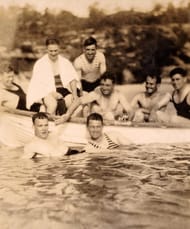
A relaxing day for the MCC England cricket team in Sydney as they prepare for the Ashes Test matches. In the boat are, left-right: Freddie Brown, George Duckworth, Eddie Paynter, Wally Hammond, unidentified local man, and Bill Voce. In the water, Tom Mitchell and Maurice Leyland.
The idea for Bodyline supposedly came about when Douglas Jardine, England’s captain, was shown film footage of Bradman batting at the Oval and noticed that he flinched whenever a ball bounced up at his chest. It was decided that more of these deliveries needed to be utilised in the return tour and that the perfect men to do it were the incomparable pace men from Nottinghamshire, Larwood and his team mate, Billy Voce.
The tactic worked and England won the series 4-1, but it proved controversial. It wasn’t illegal but it was new and unexpected and, with a bowler like Larwood in particular, it could be seen as dangerous. The England team, Jardine and Larwood in particular, were rumoured to fear for their safety because the Australian crowds were livid at what was seen as unsporting and against the spirit of the game. Telegrams went back and forward between Australia and London with complaints about the nature of the bowling; Jardine accused the Australian press of making the whole thing up and the Australian team threatened to stop the series, claiming to do otherwise would “upset friendly relations” between the two countries. But the MCC did nothing and the tour continued.
Years later, Harold Larwood remembered going to the theatre one night in Adelaide and overhearing a little girl say to her mother, “But Mummy, he doesn’t look like a murderer.” For all that, when Larwood scored 98 at Sydney he was given a standing ovation by the crowd as he walked back to the pavilion.
Douglas Jardine was vilified by the Australian public and is still hated to this day by Australian cricket fans. It’s highly unlikely that the MCC would appoint someone with such an unprofessional stance as their captain. It didn’t matter what people thought of the English captain, Jardine’s team had accomplished what they’d set out to do – they’d got the Ashes back.
The game of cricket, though, had changed forever. A letter written by a fan to the Sydney Morning Herald noted that if this type of thing was allowed to continue, the game would start to resemble baseball with all the players wearing helmets and pads. He was right. That is exactly what happened.
Furthermore, Bodyline-style bowling did not go away. In the 1970s, the most formidable pair of fast bowlers on the international scene were Dennis Lillee and Jeff Thompson, who bowled in a way that was designed to intimidate and sometimes hurt a batsman, not unlike Bodyline.
The Bodyline series, as it has become known, still divides people. Was it really set up just to stop one batter? Was it really intended to be dangerous? Was Jardine really a difficult man who disliked Australians and why did Larwood never play for England again after that series? Had he been made a scapegoat by the MCC or was there more to it? We may never know the answers to these questions, but what we do know is that Bodyline took a quite interesting cricket fixture and turned it into a mouth watering rivalry that sets the cricket world alight every couple of years.
Who would want it any other way?
Quotes courtesy of The Book of Ashes Anecdotes by Gideon Haigh
Follow IPL Auction 2025 Live Updates, News & Biddings at Sportskeeda. Get the fastest updates on Mega-Auction and cricket news
